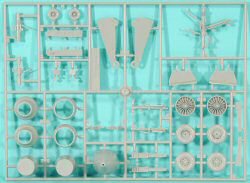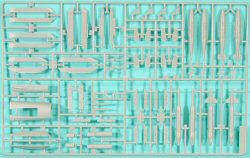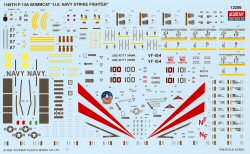
Academy 1/48 F-14A Bombcat Kit First Look
By Michael Benolkin
| Date of Review | January 2007 | Manufacturer | Academy |
|---|---|---|---|
| Subject | F-14A Bombcat | Scale | 1/48 |
| Kit Number | 12206 | Primary Media | Styrene |
| Pros | Still one of the nicest F-14 kits in 1/48 scale and now represents late service configuration | Cons | Nothing noted |
| Skill Level | Basic | MSRP (USD) | $39.00 |
First Look
 |
 |
 |
 |
 |
 |
 |
 |
 |
The F-14A Tomcat entered service with the US Navy in the early 1970s and represented one of the most advanced fleet defense assets ever developed. The aircraft's AN/AWG-9 radar provided one of the first track-while-scan capabilities in the world and provided the radar operator with a variety of unique detect, track, and engage options to suit a variety of operational scenarios. It proved its true capabilities when an F-14 Tomcat was able to engage and shoot down six different targets simultaneously with the AIM-54 Phoenix missile.
While the F-14A would serve long and proud, the US Navy would not fire the AIM-54 in anger due to rules of engagement that would come later that required visual identification of your target before weapons release. By the time you could tally and ID your bogey, you were too close for the Phoenix. The Tomcat was also armed with the AIM-7 Sparrow and AIM-9 Sidewinder. The decision was later made not to adapt the Tomcat with the AIM-120 AMRAAM.
With the advent of the multi-role Hornet entering service with the US Navy, the concept of the swing fighter was contageous. The Tomcat community knew they could carry weapons farther without refueling and with the same precision as the Hornet, and eventually they would get their chance as a variant of the LANTIRN pod would be adapted to the aircraft providing the capability to identify targets day or night, designating that target with the laser and guiding a laser-guided bomb to impact. The Tomcat would become the Bombcat.
For a look at the original F-14A release from Academy, click here.
Academy did something unique in their first Tomcat release - they molded the gun bay doors as a separate part. This was the early styled door that had louvers for venting expended gun gas out of the airframe.

The F-14B, which was essentially an F-14A with General Electric F110 engines, featured a different gun bay door area that used NACA scoops for gun bay ventilation. This design would also be standard on the F-14D and retro-fitted to the remaining in-service F-14As.

To accommodate the new doors, the underlying lower nose section was also replaced in the kit. In fact, the parts you see to the right are identical to the earlier F-14A release except one - Tree H at the bottom of this image stack.
Overall, the kit is molded in light gray styrene and presented on seven parts trees, plus an upper and lower fuselage, and a single tree of clear parts. The molding on this release is as good as ever.
The cockpit is nicely detailed and, like the Hasegawa kit, can be displayed empty or with a pair of nice crew figures seated in the 'pit'. Unlike the Hasegawa kit, the Academy F-14A can be posed with the radome open revealing the radar underneath.
The wings of the Academy kit are designed like the Revell-Monogram kit with a sweep mechanism that will allow the wings to be moved after completion. If you want to display the aircraft in the take-off or landing configuration with the flaps and slats all out, then you really want the Hasegawa kit. If you are going to simply park the aircraft with the wings swept, the Hasegawa kit is major overkill and this kit is what you're looking for.
Tree H brings this kit more up to date. It has not only the new lower nose and gun bay door section, it also adds the antenna bumps on and under the wing gloves, provides the AN/AAQ-14 LANTIRN targeting pod and pylon adapter, a pair of GBU-31(V)1 JDAMs, a pair of GBU-24 Paveway II LGBs, and even a pair of LAU-138 BOL/chaff launchers.
The Academy kit, like the Hasegawa, feature engine faces visible down the intake trunks, though the afterburner chambers are a bit shallow on the Academy kit. There are several replacement sets for the TF30 nozzles and A/B chambers out there including a nice set from Aires. The kit does provide a pair of open or closed nozzles allowing you to pose your aircraft in a variety of conditions.
Unlike the Hasegawa kit, the Academy Tomcat comes with a nice set of external stores including:
- 2 x AIM-9
- 4 x AIM-7
- 6 x AIM-54
- 1 x TARPS
- 2 x External Fuel Tanks
- 2 x GBU-24
- 2 x GBU-31
- 1 x LANTIRN Targeting Pod
Markings are included for two aircraft:
- F-14A, 161866, VF-154, NF/100, USS Kitty Hawk CAG aircraft
- F-14A, 161267, VF-154, NF/101, USS Kitty Hawk
Take a closer look at that decal sheet. Not only does Academy provide all of the distinctive markings, but maintenance stenciling, walkways, and something I haven't seen outside of TwoBobs Decals - AIM-9, AIM-9, AIM-54, and GBU weapons stencils and live-round color bands.
I am very pleased to see this kit released with all of the updates you'll need for a later service line aircraft. Even if you don't bomb up the Bombcat, the kit still has a nice assortment of air-to-air weaponry. With the updated nose vents, you'll have an easier time adding the GE engine nozzles to render a B or to use one of the many conversions to render the D-model.
While some people still swear by the Hasegawa Tomcat, this kit is by far my favorite quarter-scale F-14, especially with the updates in the kit. I am definitely looking forward to building this one!
My sincere thanks to MRC for this review sample!







